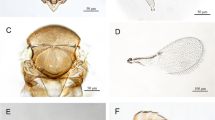Abstract
Isospora phainopepla n. sp. is described from the faeces of Phainopepla nitens (Swainson) collected in Joshua Tree National Park, California, USA. To our knowledge, there are no metazoan or protist parasites described yet from any species in the Ptiliogonatidae of the Americas. Sporulated oöcysts of the isosporan are ellipsoidal, 30-35 × 22-29 (32.9 × 25.4) μm, with a length/width (L/W) ratio 1.20-1.35 (1.30); one rice-shaped polar granule is present, but both oöcyst residuum and micropyle are absent. Sporocyts are elongate-ellipsoidal, 22-27 × 11-14 (23.9 × 12.0) μm, with L/W ratio 1.97-2.02 (2.00); prominent Stieda and sub-Stieda bodies are both present, but para-Stieda body is absent. Sporocyst residuum of many scattered granules is present and the sporozoites have prominent anterior and posterior refractile bodies. This parasite is clearly new to science and represents the first species of Isospora hosted by a New World bird species from this small family of silky flycatchers (Ptiliogonatidae). This article was registered in the Official Register of Zoological Nomenclature (ZooBank) as 7F664B0D-DF0E-4CAD-8CEA-45D79C8BBF92. This article was published as an Online First article on the online publication date shown on this page. The article should be cited by using the doi number. This is the Version of Record.


Similar content being viewed by others
References
Berto, B. P., & Lopes, C. W. G. (2013). Distribution and dispersion of coccidia in wild passerines of the Americas. In: Ruiz, L. & Iglesias, F. (Eds), Birds: evolution and behavior, breeding, strategies, migration and spread of disease. Hauppauge, NY, USA: Nova Science Publishers, Inc. pp. 47–65.
Berto, B. P., Balthazar, L. M. C., Flausino, W., & Lopes, C. W. G. (2009). New isosporoid coccidian parasites of sayaca tanager, Thraupis sayaca, from South America. Acta Parasitologica,54, 90–94.
Berto, B. P., McIntosh, D., & Lopes, C. W. G. (2014a). Studies on coccidian oöcysts (Apicomplexa: Eucoccidiorida). Revista Brasileira de Parasitologia Veterinária,23, 1–15.
Berto, B. P., Medina, J. P., Salgado-Miranda, C., García-Conejo, M., Janczur, M. K., Lopes, C. W. G., et al. (2014b). Isospora celata n. sp. (Apicomplexa: Eimeriidae) from the orange-crowned warbler Oreothlypis celata (Say) (Passeriformes: Parulidae) in Mexico. Systematic Parasitology,89, 25–257.
Chu, M., & Walsberg, G. (1999). Phainopepla (Phainopepla nitens), version 2.0. In: Poole, A. F. & Gill, F. B. (Eds), The Birds of North America. Ithaca, NY, USA: Cornell Lab of Ornithology, https://doi.org/10.2173/bna.415
Duszynski, D. W., & Wilber, P. (1997). A guideline for the preparation of species descriptions in the Eimeriidae. Journal of Parasitology,83, 333–336.
Howell, S. N. G., & Webb, S. (1995). A guide to the birds of Mexico and Northern Central America. New York: Oxford University Press.
Luna-Castrejón, L. P., Ravines-Carrasco, L., Salgado-Miranda, C., & Soriano-Vargas, E. (2018). The canary Serinus canaria (Passeriformes: Fringillidae) as a new host for Isospora bioccai. Systematic Parasitology,7, 445–449.
McAllister, C. T., & Hnida, J. A. (2019). A new eimerian (Apicomplexa: Eimeriidae) from the barn swallow, Hirundo rustica (Aves: Passeriformes: Hirundinidae), in southeastern Oklahoma: The fourth eimerian species from New World Passeriformes. Journal of Parasitology, 105, 693–696.
Ogedengbe, M. E., El-Sherry, S., Ogedengbe, J. D., Chapman, H. D., & Barta, J. R. (2018). Phylogenies based on combined mictochondrial and nuclear sequences conflict with morphologically defined genera in the eimeriid coccidia (Apicomplexa). International Journal for Parasitology,48, 59–69.
Pereira, L. Q., Berto, B. P., Flausino, W., Lovato, M., & Lopes, C. W. G. (2011). Isospora bocamontensis n. sp. (Apicomplexa: Eimeriidae) from the yellow cardinal Gubernatrix cristata (Vieillot) (Passeriformes: Emberizidae) in South America. Systematic Parasitology,78, 73–80.
Salgado-Miranda, C., Medina, J. P., Zepeda-Velázquez, A. P., García-Conejo, M., Falindo-Sánchez, K. P., Janczur, M. K., et al. (2016). Isospora cardellinae n. sp. (Apicomplexa: Eimeriidae) from the red warbler Cardellina rubra (Swainson) (Passeriformes: Parulidae) in Mexico. Systematic Parasitology,93, 825–830.
Soriano-Vargas, E., Medina, J. P., Salgado-MIranda, C., García-Conejo, M., Galindo-Sánchez, K. P., Janczur, M. K., et al. (2015). Eimeria pileata n. sp. (Apicomplexa: Eimeriidae) from the rufous-capped brush finch Atlapetes pileatus Wagler (Passeriformes: Emberizidae) in Mexico. Systematic Parasitology,92, 261–265.
Soriano-Vargas, E., Salgado-Miranda, C., Zepeda-Velázquez, A. P., Medina, J. P., Janczur, M. K., González-Gómez, M., et al. (2017). Eimeria atlapetesi nom. nov., a replacement name for Eimeria pileata Soriano-Vargas et al., 2015 (Apicomplexa: Eimeriidae), preoccupied by Eimeria pileata Straneva and Kelly, 1979 (Apicomplexa: Eimeriidae), with observations on histopathology and phylogenetic analysis. Zootaxa,4227, 144–150.
Tenter, A. M., Barta, J. R., Beveridge, I., Duszynski, D. W., Mehlhorn, H., Morrison, D. A., et al. (2002). The conceptual basis for a new classification of the coccidia. International Journal for Parasitology,32, 595–616.
Funding
This study was funded by Institute for Biodiversity Research, Development & Sustainability (iBIRDS, Mexico).
Author information
Authors and Affiliations
Corresponding author
Ethics declarations
Conflict of interest
The authors declare that they have no conflict of interest.
Ethical approval
All applicable institutional, national and international guidelines for the care and use of animals were followed.
Additional information
Publisher's Note
Springer Nature remains neutral with regard to jurisdictional claims in published maps and institutional affiliations.
Rights and permissions
About this article
Cite this article
Salgado-Miranda, C., García-Albarrán, M.A., Duszynski, D.W. et al. Isospora phainopepla n. sp. (Apicomplexa: Eimeriidae) from Phainopepla nitens (Swainson) (Passeriformes: Ptiliogonatidae) in the Joshua Tree National Park, USA. Syst Parasitol 96, 795–798 (2019). https://doi.org/10.1007/s11230-019-09886-4
Received:
Accepted:
Published:
Issue Date:
DOI: https://doi.org/10.1007/s11230-019-09886-4




